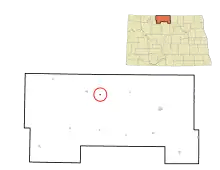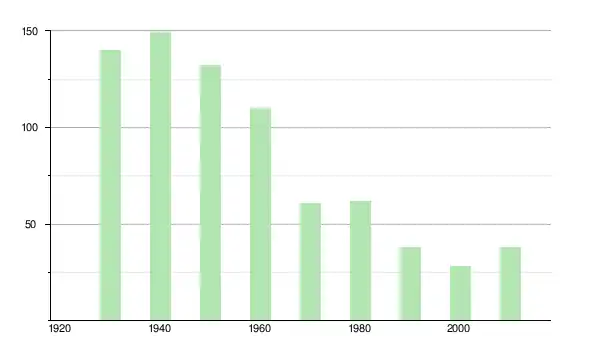Landa (Dakota du Nord)
La ville de Landa est située dans le comté de Bottineau, dans l’État du Dakota du Nord, aux États-Unis. Selon le recensement de 2010, sa population s’élève à 38 habitants.
Landa

Landa en 2000.
| Pays | |
|---|---|
| État | |
| Comté | |
| Superficie |
0,2 km2 () |
| Surface en eau |
0 % |
| Altitude |
452 m |
| Coordonnées |
48° 53′ 47″ N, 100° 54′ 41″ O |

| Population |
41 hab. () |
|---|---|
| Nombre de ménages |
23 () |
| Densité |
208,3 hab./km2 () |
| Statut |
|---|
| Fondation |
|---|
| Code postal |
58783 |
|---|---|
| Code FIPS |
38-44700 |
| GNIS | |
| Indicatif téléphonique |
701 |

Histoire
Landa a été fondée en 1904.
Démographie
| Historique des recensements | |||
| Ann. | Pop. | %± | |
|---|---|---|---|
| 1930 | 140 | — | |
| 1940 | 149 | ▲ +6,43 % | |
| 1950 | 132 | ▼ −11,41 % | |
| 1960 | 110 | ▼ −16,67 % | |
| 1970 | 61 | ▼ −44,55 % | |
| 1980 | 62 | ▲ +1,64 % | |
| 1990 | 38 | ▼ −38,71 % | |
| 2000 | 28 | ▼ −26,32 % | |
| 2010 | 38 | ▲ +35,71 % | |
| Groupe | Landa | ||
|---|---|---|---|
| Blancs | 100 | 90,0 | 72,4 |
| Autres | 0 | 10,0 | 27,6 |
| Total | 100 | 100 | 100 |
| Latino-Américains | 0 | 2,0 | 16,7 |
Selon l'American Community Survey, pour la période 2011-2015, 98,08 % de la population âgée de plus de 5 ans déclare parler l'anglais à la maison et 1,92 % une autre langue[3].

Source
- (en) Cet article est partiellement ou en totalité issu de l’article de Wikipédia en anglais intitulé « Landa, North Dakota » (voir la liste des auteurs).
Notes et références
- (en) « Population of North Dakota - Census 2010 and 2000 », sur censusviewer.com.
- (en) « Landa, ND Population - Census 2010 and 2000 », sur censusviewer.com.
- (en) « Language spoken at home by ability to speak English for the population 5 years and over », sur factfinder.census.gov.
- (en) « Statistiques des États-Unis - Dakota du nord - Profils des comtés de 2010 » (consulté en )
Liens externes
- Ressource relative à la géographie :
Cet article est issu de wikipedia. Text licence: CC BY-SA 4.0, Des conditions supplémentaires peuvent s’appliquer aux fichiers multimédias.